You’ve repeatedly put off your most important project, and now, it’s crunch time. If you don’t complete your task by its deadline, you’ll let your teammates, manager, and yourself down.
If this sounds familiar, you probably let procrastination get the best of you. Why not change that once and for all?
With productive procrastination, you can use your downtime to boost your overall productivity.
In this article, we explore what productive procrastination is, its benefits, and how you can make it your superpower.
Why do we procrastinate in the first place?
Procrastination often involves a few thoughts and emotions that drive people to put off a certain task or activity.
To avoid a dreaded or unpleasant task
Maybe you’re repeatedly postponing a medical procedure or putting off working on an essential report until the last minute.
Unfortunately, the greater your aversion to an upcoming task, the greater your tendency to procrastinate.
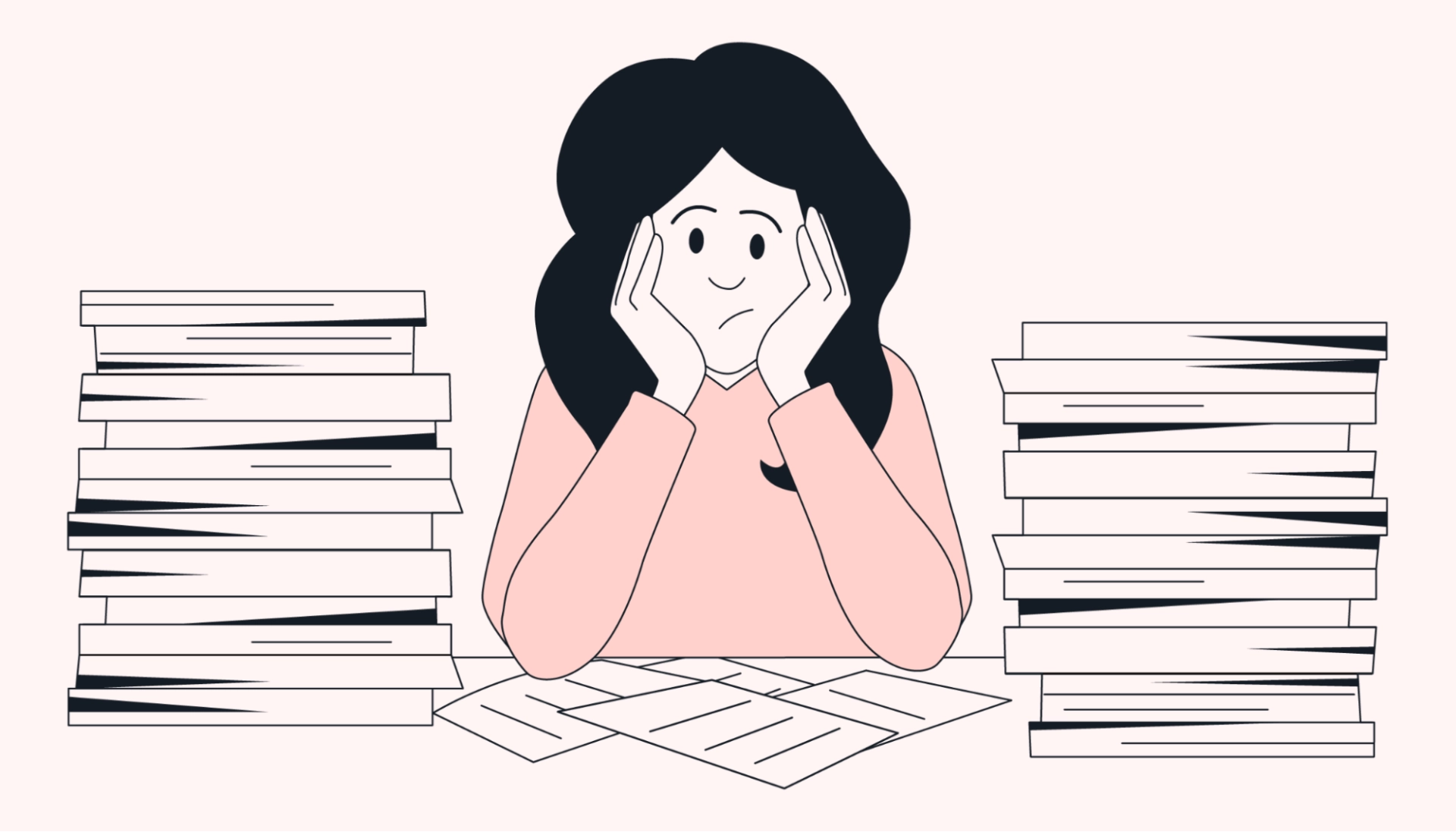 |
You feel overwhelmed by a task’s size, intensity, or scope
Finding a new home or tackling a critical, long-range work project may be intimidating. You spend too much time debating where to begin and end up frantically trying to catch up.
You fear failure or worry about the possible outcomes
Ignoring that nagging medical symptom may feel easier than heading to the clinic to determine the cause.
Tendencies toward negative perfectionism are also associated with procrastination.
You lack motivation or confidence in your abilities
A lack of confidence in your abilities or the motivation to get started also influences procrastination. If you wait to feel good enough (or even to just feel ready), you may put off the activity indefinitely.
The good news? Procrastination can be used to your advantage. Here’s how:
What is productive procrastination?
Productive procrastination is a way of putting off something you don’t want to do while still accomplishing something meaningful or productive in the meantime. It’s also called structured procrastination, a term coined by Stanford philosophy professor John Perry in 1995.
In Perry’s book The Art of Procrastination: A Guide to Effective Dawdling, Lollygagging, and Postponing, he writes, “Structured procrastination is the art of making the negative trait work for you.”
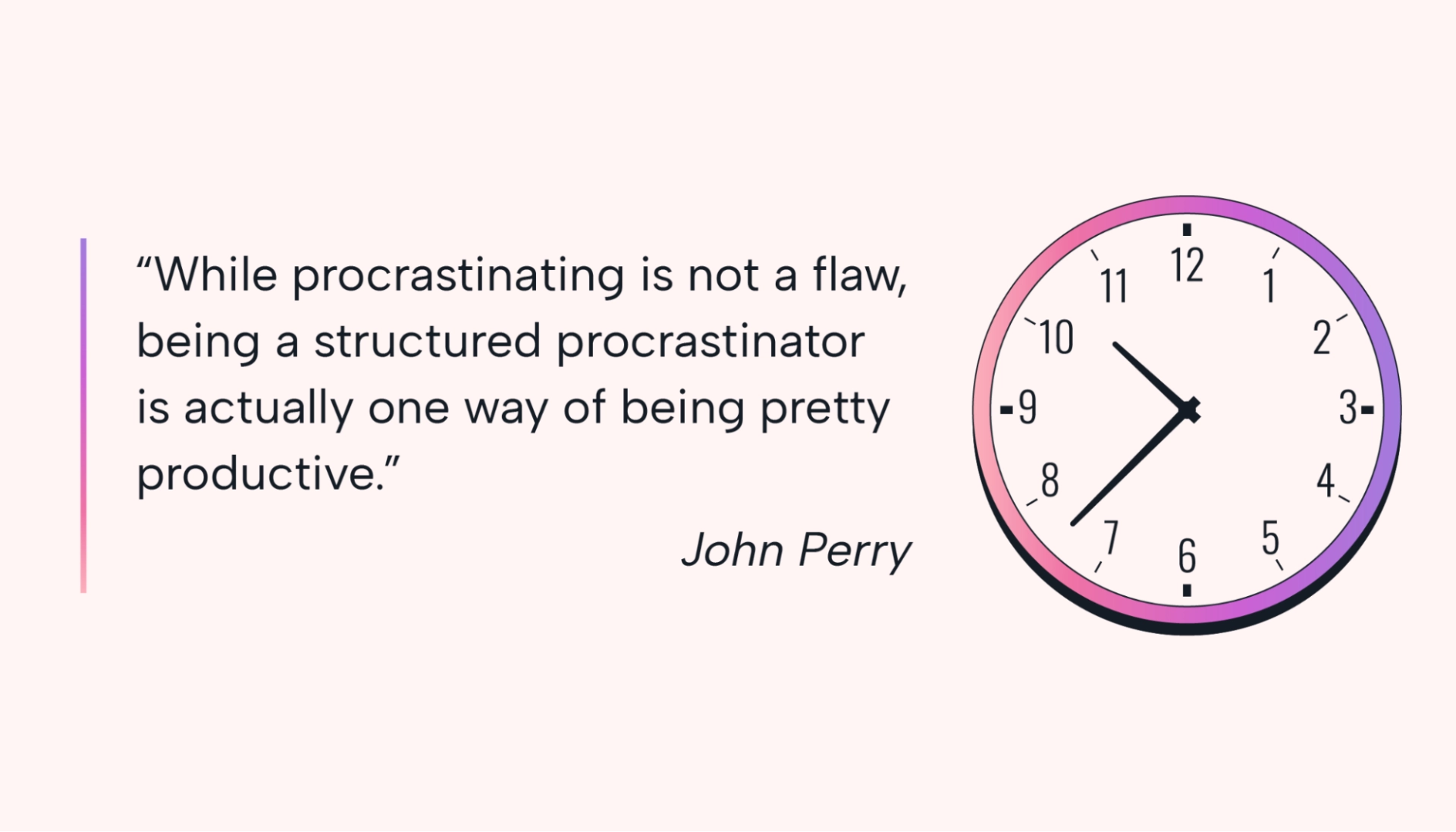 |
Dr. Perry also notes, “The procrastinator can be motivated to do difficult, timely, and important tasks, however, as long as these tasks are a way of not doing something more important.”
Essentially, if the time you spend procrastinating on a big project is spent on a functional or productive task, it’s not wasted. However, if you spend that time scrolling through your phone, you’ve simply procrastinated.
Can productive procrastination really boost performance?
Productive procrastination is a handy tool that can improve your productivity — if you use it correctly.
Here are the specifics on productive procrastination and performance:
- Productive procrastination allows you to feel (and be) productive even if you’re not working on the primary task.
- It also boosts your motivation to complete smaller but still meaningful tasks.
- If you procrastinate productively, your brain enjoys a break from the high cognitive effort required for your primary task. Your mind has a chance to recharge, and you feel that your energy is renewed once you return to the activity.
- Productive procrastination allows you to work on new skills or devote time toward other significant personal or work goals.
Is there a downside to productive procrastination?
While productive procrastination offers many benefits, it’s important to be mindful of some potential drawbacks:
- If you don’t structure your time, procrastination results in you putting off your most important tasks for too long. This leads to higher stress and anxiety — plus the likelihood of overcommitment if you take on too much.
- As with any type of procrastination, productive procrastination reinforces the tendency to continue avoidance behaviors.
- Too much procrastination has long-term effects on well-being and confidence, especially if you continually miss important deadlines or put off essential appointments.
Now, let’s turn to specific ways you can procrastinate productively.
Strategies to leverage productive procrastination to your advantage
Here are the top ways to reap the benefits of productive procrastination.
1. Understand your “why”
Knowing why you’re procrastinating makes it easier for you to address it.
Are you a perfectionist, or maybe afraid of failure? Are you unsure of where to start with a long-range project? Or is your brain simply in need of a break?
Your everyday risk of procrastination increases when you’re faced with a stressful situation, as this gives you a reason to avoid the issue altogether. However, the relief you feel from avoiding the task is temporary. You have to face the project again and risk repeating the cycle.
Address your “why” by improving your coping mechanisms and emotional regulation skills for more effective outcomes in the long run.
2. Plan out the rest of your day
Organizing the events and activities in your work and personal life gives you a mental break from cognitively taxing work.
Achieve some organizational clarity and focus on what you need to accomplish. Attaching priorities ensures you’re not bogged down or distracted by the less important items on your to-do list.
Knowing what’s in store also lets you return to your primary activity refreshed and focused since you’ve planned for your other needs.
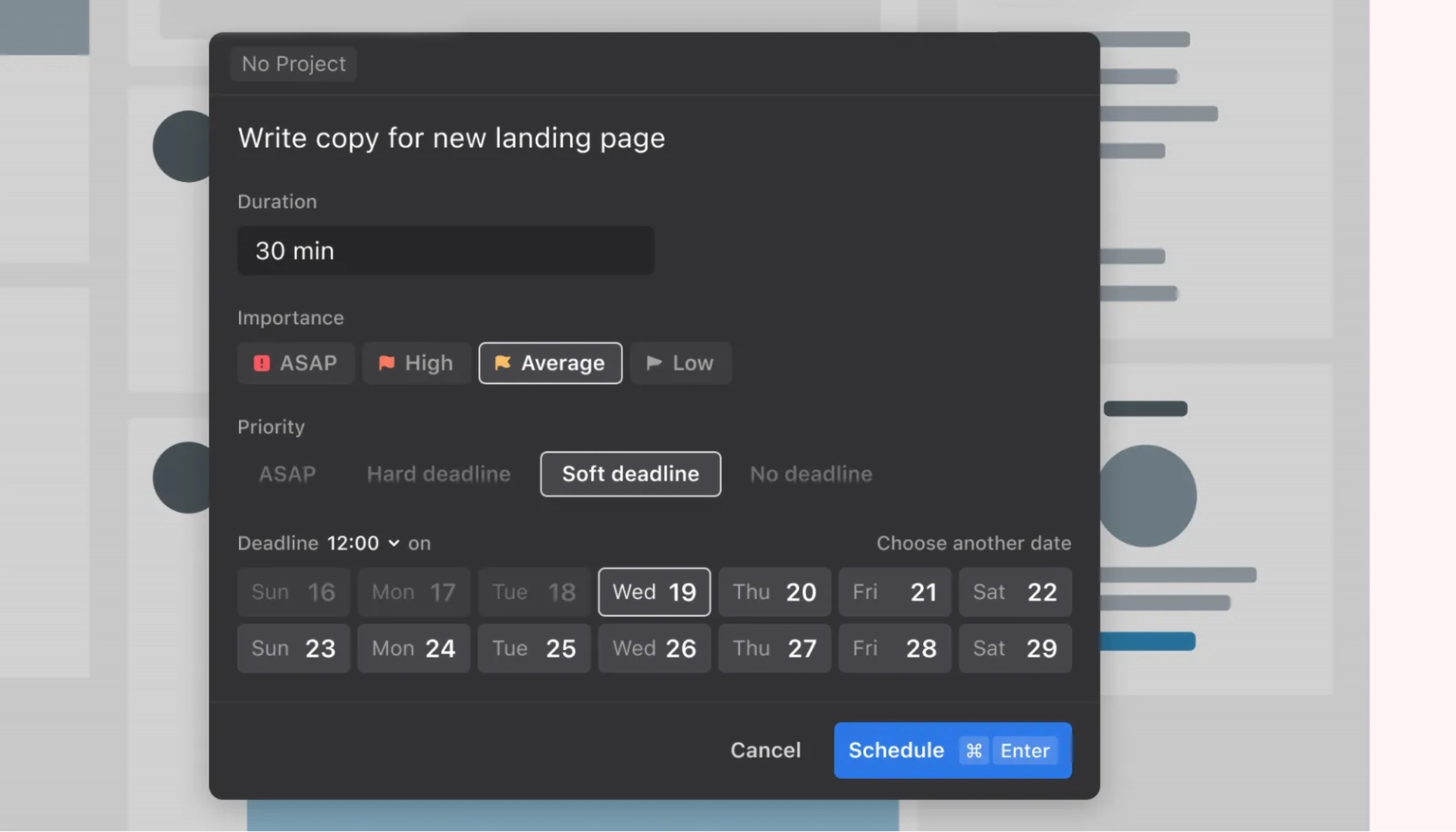 |
Motion’s Task Manager accomplishes task scheduling for you. Prioritize your tasks on the platform, and the AI will slot them into the perfect spots. Get rid of your to-do list, as Motion takes away the stress of trying to recall and complete all your tasks.
3. Establish your goals
If you know what matters to you, you can use that motivation during periods of productive procrastination.
For example, if you’re interested in taking on leadership roles within your company, download a podcast or read an inspirational book.
Or maybe you’ve always wanted to bake homemade sourdough. Sign up for an online class or get a proof ready to rise.
With this approach, you’re still accomplishing something meaningful with your time.
Also, write down your primary and secondary goals for both your work and home lives. Focus on SMART goals, too — goals that are specific, measurable, achievable, relevant, and time-bound. Decide whether setting medium-term goals will also help keep you on track.
4. Tackle the overwhelming feelings
Many procrastinators avoid large-scale projects because they don’t know where to start. If this is you, break down the activity into smaller steps.
For example, if you’re starting to look for a new home, list the steps you need to move forward. You can start by getting pre-approved for a new home loan and enlisting a realtor to begin your search.
Listing and achieving each step helps you monitor your project’s progress. This is a better alternative to staring blankly at your computer screen or avoiding the project altogether.
Do you have a large project you need to put together for your team? Motion’s Project Manager feature tackles project management-related stress by automating 90% of project planning.
5. Get moving
If you dread starting or working on a new project, slot in a movement break. Do what you enjoy: walk, stretch, or practice yoga, for instance.
Regular physical activity that includes varying exercise intensity strengthens functional connections among different areas of the brain.
You can then get back to work with renewed physical and mental energy, ready to return to your project’s demands.
6. Take a mental break
The brain can only sustain focused effort and concentration for so long. So, pair intensive work blocks with mental breaks. This lets you briefly rest and return to your work refreshed and energized.
Ensure your mental break is effective, too. Don’t just turn to your phone and start scrolling.
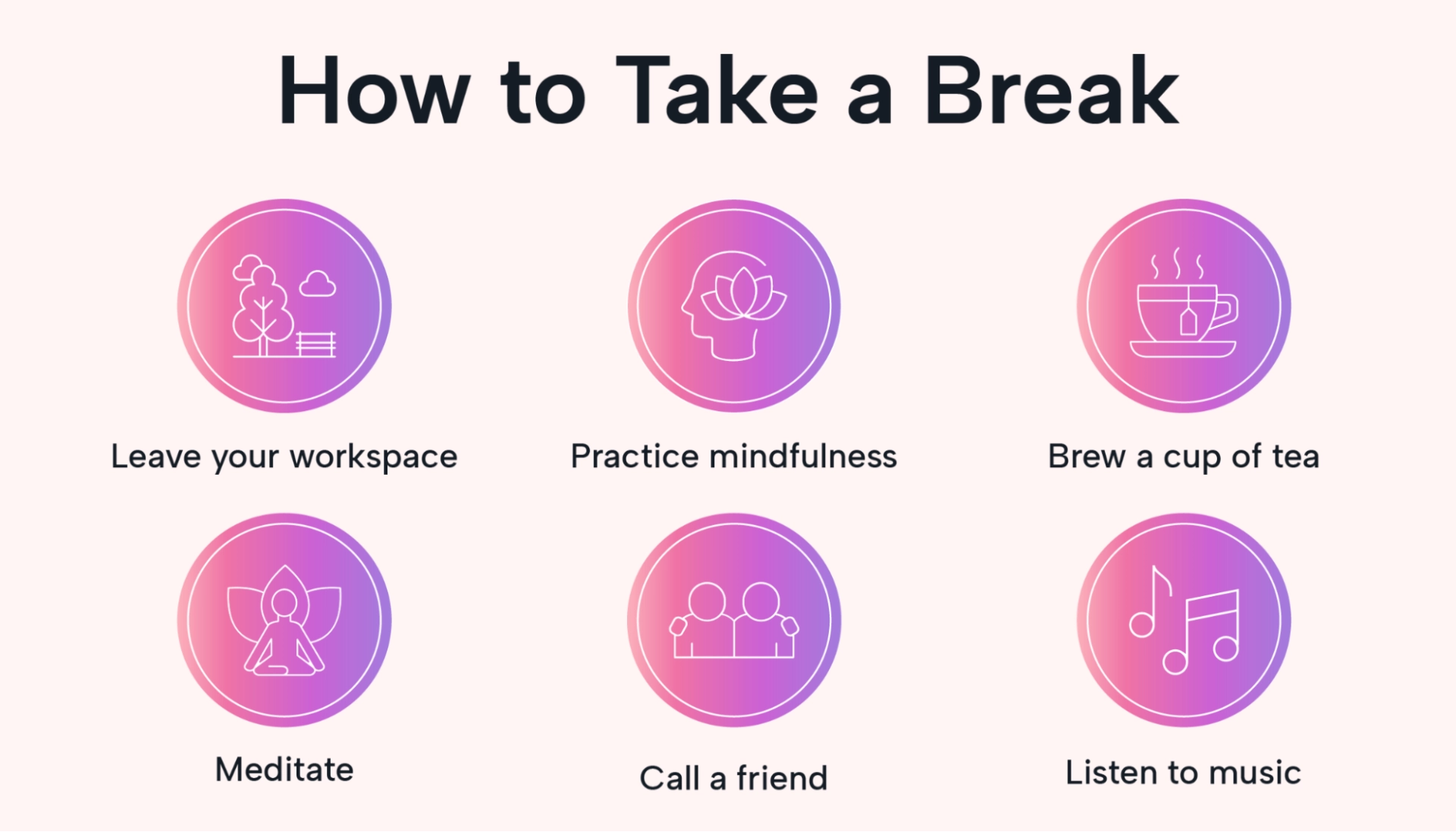 |
Leave your workspace. Head to the break room or outside to your patio, for example. Work in mindfulness, meditation, or Zen habits for clarity and focus. Call a friend or family member to strengthen your personal relationships.
Build breaks throughout the day, and make sure you take them. Set a recurring task reminding you to stand and stretch, brew a cup of tea, drink a glass of water, or practice mindfulness.
7. Shift into “creative mode”
Use productive procrastination to tackle a creative project. Creative works allow your mind to relax, and you can engage different areas of the brain.
Productive procrastination that involves creativity is effective because you’re still accomplishing something important to you, whether the activity is tied to your personal or professional goals.
Work on your brand, brainstorm new project ideas with your colleagues, or create a social media post.
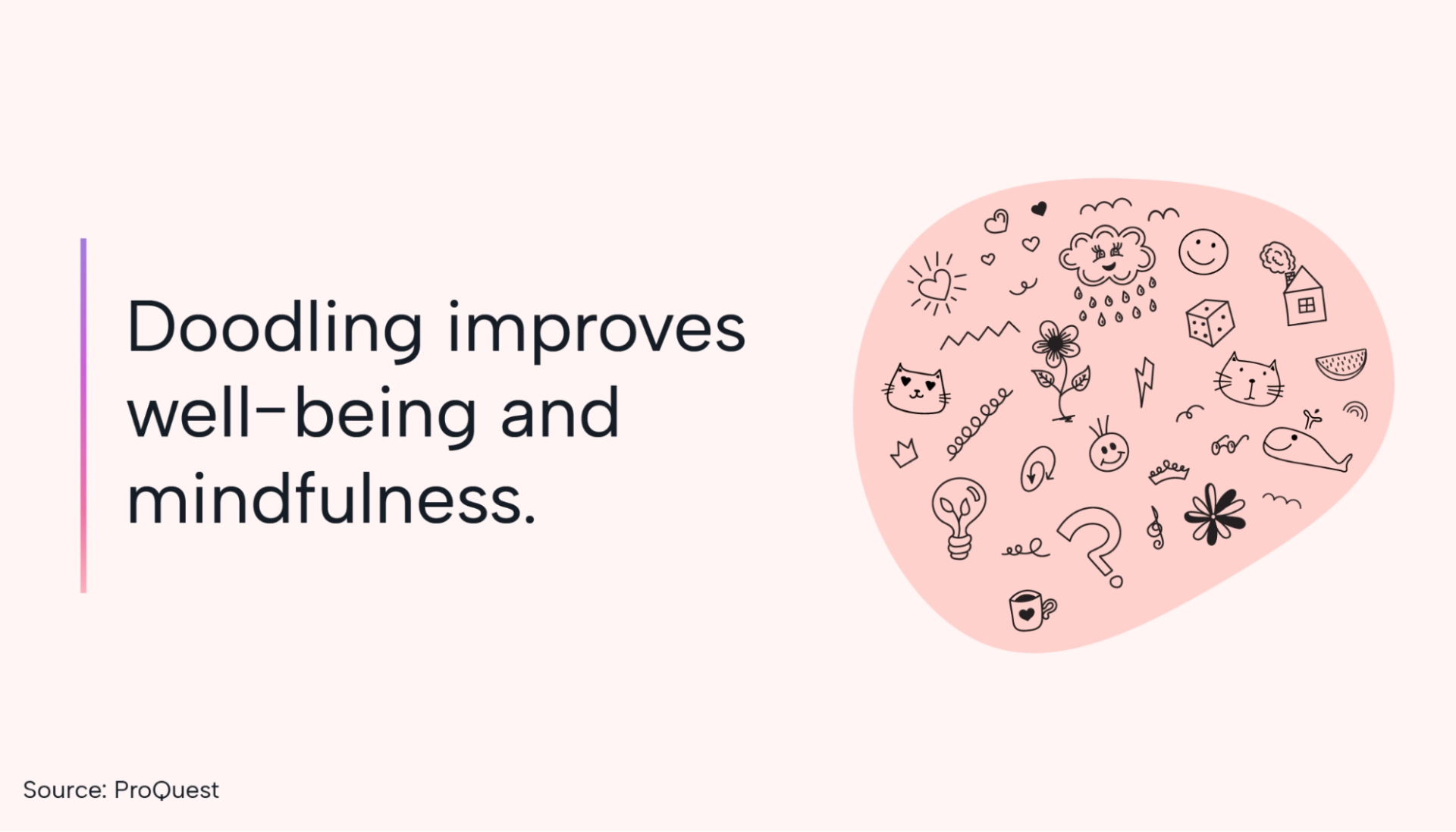 |
Doodle new ideas to improve your well-being and mindfulness. Whether you take a few moments to sketch out a new backyard layout or a graph for your presentation, you’re still working toward your goal.
8. Get out the scrub brush
Did you know that cleaning is an effective way to shift your focus? Its mindless nature means you can accomplish something productive while letting your brain wander or decompress. Another upside is that you probably won’t want to do it for long, so you’ll be ready to return to your project when it’s done.
If you work from home, tidy your kitchen or fold some laundry. And if you’re in the office, load some dishes into the break room dishwasher or organize your desk.
Decluttering is also effective at streamlining your work areas and reducing distractions. When you return to your primary project, you’ll have renewed concentration and a fresh workspace.
9. Plan a getaway
Why not use your productive procrastination to give yourself a reward? Planning a vacation, a long weekend away, or a spa day can boost your mood and energy levels. It also gives you something to look forward to.
Scheduling this reward for when you’ve wrapped up a project or completed a particularly challenging task gives you an added incentive to complete it.
Engaging reward systems inhibits the stress response and improves health outcomes, positioning you to return to work restored and energized.
If a vacation isn’t on the books, plan something smaller: a dinner date, a trip to the zoo with your kids, or an evening at the theater with friends. Putting this activity on the calendar can give you that extra oomph to return to your primary project.
Best practices for procrastinating productively
Follow these guidelines to ensure success regardless of which strategy you use for productive procrastination:
Give yourself a pat on the back
Chronic procrastination leads to long-term adverse effects on your health, such as anxiety, low self-esteem, decreased confidence, and reduced motivation. It can also impact your well-being by reducing emotional competence, leaving you feeling defeated before you even start.
You can combat these negative effects with productive procrastination. Engage in a meaningful activity to stay on track to meeting your goals.
Recognize what you’re doing well, and acknowledge your progress along the way. Sometimes, you just need a pat on the back. Take a deep breath and feel gratitude for what you’ve accomplished.
 |
And remember: don’t let your moods rule your behaviors. Engage in positive self-talk so that you aren’t tempted to pick up your phone instead and start scrolling or texting.
Finally, use Motion to create the perfect schedule by incorporating necessary mental or physical breaks.
Use time-management techniques
Multiple time-management techniques exist, so try out a few to learn which ones work best for you. Time-blocking templates and focus workblocks ensure you devote sufficient time to what’s essential.
Some prefer to “eat the frog” by tackling the toughest part of their day first. Others use the Pomodoro technique to ensure they take frequent breaks and maintain cognitive energy.
Motion offers enhanced time tracking so that you can know exactly how you spend your time. Build periods of productive procrastination into your routine, such as taking a brisk walk or brainstorming new blog ideas. That way, you won’t have to dread longer work blocks.
Reward your efforts
Recognize your accomplishments with small, specific, and tangible rewards. When you recognize that productive procrastination is actually working, you’ll be more inclined to do it again (rather than unproductive procrastination).
Dopamine receptors affect the anticipation of future rewards, making you more likely to continue with a task that comes with a reward.
Set incentives at the outset to motivate you to complete small steps and large-scale projects. Successfully completing tasks leads to more positive energy and improved mental, physical, and work outcomes.
Make the most of your valuable time with Motion
While persistent procrastination can be harmful in the long run, productive procrastination doesn’t have to be — not if you implement these strategies to make the most of your time.
Why not make productivity even easier with Motion?
Use the Task Manager to list and prioritize each task you need to get done. It puts each task in the right place to ensure you stay on track and on time. Even better, if parts of your schedule change, Motion automatically adjusts your priorities in real time.
Don’t wait to make the most of your time. Contact Motion and sign up for a 7-day risk-free trial today.

Jodi Monroe is a content writer and blogger in the SaaS space. When not at her laptop, she’s planning her next travel adventure.




